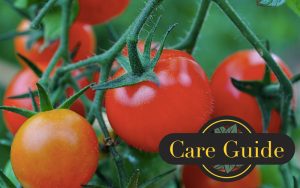
What Matters with ‘Maters
Click Here to view or download this guide as a PDF.
Tomatoes are the most popular vegetable grown in the home garden. And for good reason – growing your own tomatoes is a great way to produce fruits with more intense flavor than you can buy in stores. Try different varieties to experience different flavors and uses. Here’s some information that may help you decide which tomatoes to grow.
Tomatoes can be categorized several different ways. Hybrids vs. open-pollinated is one way to discriminate between tomatoes. Hybrids, often labeled F1, are intentional crosses between 2 distinct parents or varieties. This can produce a plant with better disease resistance, higher yield and good flavor. Their dis-advantage is that they don’t come true from seed, reverting to the dominant parent. New seeds need to be purchased every year if you start your tomatoes from seed (another choice – seed is more economical than starting with transplants).
With open-pollinated plants, if pollen is not shared between different varieties within the same species, the seed produced will remain true-to-type year after year. Open-pollination occurs through natural mechanisms like wind, insects and birds and isn’t restricted to pollinating certain individuals as when plants are hybridized. This results in more genetic variability in plants and a stronger, more diverse population. The trend toward decreased agricultural biodiversity and the loss of unique varieties can pose hardships in future food production. Supporting biodiversity in garden vegetables can be an important role of home gardeners.
Heirlooms are a type of open-pollinated tomato. They have been passed down through several generations of a family because of a desired characteristic and suitability to an area. Brandywine is an example. Although as a rule they don’t have as much tolerance to disease as hybrids, they are valued for flavor, nutrition and sometimes unique color. Growing heirloom varieties helps to carry on our garden heritage.
The growth characteristic of plants is another way tomatoes differ. Determinate varieties grow to a certain predetermined size then stop growing, so fruit is produced over a shorter period. This can be advantageous if you want more fruit in a smaller time, as for canning and it is also easier to grow these in small-er areas such as patio gardens, and without extensive trellises. Indeterminate types continue to grow until weather restricts them and they produce fruit over a longer period.
These differences can also help you decide which tomatoes to grow:
Cherry tomatoes are bite-sized round tomatoes with high sugar content and can be eaten right out of hand, in salads and sautés. They come in red, orange, yellow or black varieties. Some of the most reliable are Super Sweet 100, Sun Gold and Black Cherry. They seem to stand up to the heat and produce a little longer than some of the larger tomatoes.
Grape tomatoes are similar in size to the cherries, their shape being a little more elongated and their skin a little thicker and less likely to split. Juliet is a notable example.
Plum, or Roma, tomatoes are also elongated but about the size of an egg. They are typically meaty with a low water content, so useful for cooking and canning.
Pear tomatoes are small like the cherry tomatoes but tear-drop shaped, usually yellow and milder flavored. These are great fresh or in tomato preserves.
Slicer or globe tomatoes are smooth and round and range up to the size of a baseball. They make perfect size slices for topping sandwiches, or in salads. Celebrity is a favorite.
Beefsteaks are very large irregular-shaped tomatoes that are usually wider than tall, somewhat like a pumpkin. The rounder types have a sweeter flavor. They are usually red or pink but Black Krim is a beefsteak. Known for rich flavor, meatiness and juiciness, they are well used fresh, in sauces and dips.
The above-mentioned tomato varieties, along with Cherokee Purple, Rutgers Improved, Green Zebra, Aunt Ruby’s German Green, Taxi, Jaune Flamme, Arkansas Traveler and Tasti Lee, are varieties especially recommended by the University of Florida. You can’t go wrong with any of them.
